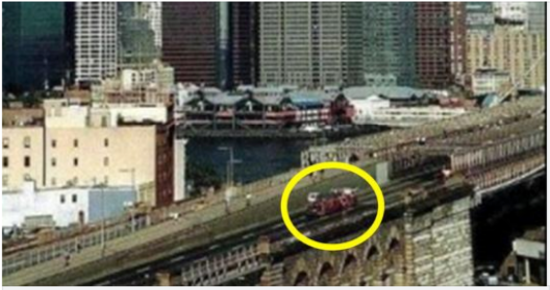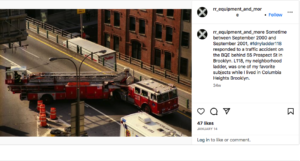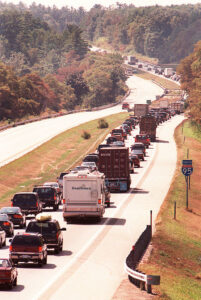
Aaron McLamb, a hobbyist photographer, was on his way to his 10th story office near the Brooklyn Bridge on September 11, 2001, when an aircraft plane slammed into the North Tower. The then-20-year-old watched in terror as a second plane flew into the South Tower less than 20 minutes later.
McLamb grabbed his camera and captured an iconic image of a red fire engine flaming across the Brooklyn Bridge, with the burning World Trade Center looming in the background.
The truck, NYPD Ladder 118, was on its way to a fire call in Lower Manhattan, and no one knew it would be the last call those six firemen would ever attend. McLamb, who had passed by the station several times previously, said he respected their daring and that “not all heroes wear capes.”

Aaron McLamb, a 20-year-old North Carolina resident, grew up wanting to be a fireman and frequently passed by the FDNY Ladder 118 station on Middagh St. in Brooklyn, interacting with the workers who were present.
McLamb is an amateur photographer who goes by the Instagram name rr_equipment_and_more. He was frequently photographing the truck, but he never intended the one he took on September 11, 2001, to become a famous image that commemorated the final run of six firemen.
McLamb was on the 10th story of a Jehovah’s Witness building near the Brooklyn Bridge when the first plane hit the World Trade Center, carrying 20,000 gallons of jet fuel.
He watched in horror as flames erupted from the North Tower, and then, shortly after 9 a.m., a second plane emerged in the sky, moving swiftly toward the World Trade Center before slicing into the south tower on the 60th level.
He took his camera from a storage closet, positioned himself outside a bay window, and began photographing.
“When I saw the fire trucks going across the bridge, I just had to start taking pictures of them, with no understanding that those guys wouldn’t come back,” McLamb, now 37, told the Daily News. “It was almost surreal being that high up looking at everything going on down below. You couldn’t hear the crackling of the fire or the creaking of the buildings. The only thing we could hear were the sirens from the fire trucks going across the bridge.”
Ladder 118 may be seen crossing the Brooklyn Bridge on their way to the World Trade Center at the bottom of this snap…Posted on Sunday, August 23, 2020 by Law Enforcement Officers Weekend
One of McLamb’s photographs, which depicts Ladder 118 crossing the Brooklyn Bridge and a rising plume of black smoke from the buildings behind, became one of the most recognized images of the 9/11 attacks.
Vernon Cherry, Leon Smith, Joey Agnello, Robert Regan, Pete Vega, and Scott Davidson left the Brooklyn Heights fire station after the second jet smashed into the South Tower.
The six men from Ladder 118 raced deeper into the chaos and landed at the Marriott World Trade Center Hotel, which was smashed around them when the 110-story towers collapsed.
Survivors described seeing heroes wearing helmets with the number 118 running up the stairs to assist visitors. They were never seen again alive.
Our Fall 2022 public program lineup begins this Thursday with “Rebuilding After 9/11: How the Fire Department of…On Monday, September 26, 2022, the National September 11 Memorial & Museum posted
Bobby Graff, a former elevator mechanic at the hotel said, “They knew what was going on, and they went down with their ship.” Referencing the hundreds of guests and Marriott employees that survived, he continued “They weren’t going to leave until everyone got out. They must have saved a couple hundred people that day. I know they saved my life.”
Graff afterwards spoke with station employees and recounted how the brave team refused to leave until they had securely fled the facility.
Retired firefighter John Sorrentino shared, “They heard the rumble of the tower coming down and Graff, everyone just started running. After the smoke cleared [Graff] was in a spot where he survived and everyone else died.” Sorrentino continued, “[Graff] could see the look on the guys faces from 118, that they knew that this was going to end bad, but they weren’t leaving because they wanted to get as many people out safely that they could.”
Sorrentino added, “And that’s how we found out what Ladder 118 did that day.”

Some of the soldiers from Ladder 118 were discovered within a few feet of one another, while others were discovered days or weeks later. The truck, which was last seen rushing across the bridge to the scene, was a twisted wreck of steel and glass that was recovered just days after the incident.
Firefighters excavating through the rubble two months later discovered tools embossed with the Ladder 118 emblem. The Ladder 118 heroes
Vernon Cherry, a 30-year veteran of the FDNY, planned to retire at the end of the year. The 49-year-old, who lives in New York City with his wife and three children, worked as a wedding vocalist as well. Cherry, according to a firefighter at the hall, “He would just sing. He would be walking up the stairs, in the locker room, taking a shower. He had such a beautiful voice.”
Leon Smith, 48, a father of three, joined the FDNY in 1982 as the chauffeur-the-driver for Ladder 118. Irene, his mother, remarked of her son, “He would wash his rig every single day, and when he went off duty, he’d say, ‘Listen, my baby better be clean.’ He called that his girlfriend.”
Joseph Agnello was a 35-year-old father of two “who loved his kids, his dogs, his life. “People on my block didn’t know my husband was a fireman,” said his wife, Vinnie Carla Agnello. “He never need to talk about himself or the job. He wasn’t the type of person who needed attention.”
Lt. Robert “Bobby” Regan, 48, started his career as a civil engineer but joined FDNY to spend more time with his young children. “He was Mr. Mom,” said his wife Donna. “There was never a day that went by that we didn’t know what we had. We told our kids not everybody gets to be as happy as we are.”
Before joining the FDNY in 1995, Pete Vega served in the United States Air Force for six years, including in Desert Storm before being honorably discharged.Regan, his wife and children’s mother, said Pete, 36, called her right before jumping on Ladder 118. She recalls his warm and caring nature: “If he was cleaning out our gutter, he would clean the neighbor’s, too.”
Members of the FDNY take a minute of silence at Engine 205 and Ladder 118.On Monday, September 11, 2017, the New York City Fire Department (FDNY) posted
Scott Davidson, the father of Saturday Night Live comedian Pete Davidson, began his career as a firefighter in 1994. Only three weeks later, the body of the 33-year-old man was found from the rubble. He was known for his sense of humour, his golden heart, and his love of Christmas. Pete remarked of his childhood trauma, “You know, Dad says he’s coming to pick you up and he doesn’t. For life, I’m like, I don’t believe anyone…” he said.
Agnello, Vega, and Cherry are still together, buried in adjacent plots in Brooklyn’s Green-Wood Cemetery. “They were found side by side, and they should stay side by side,” said Agnello’s wife.
The team of Ladder 118 are six of 343 firefighters who died in 9/11, a number that–according to USA Today–represented almost half the number of “on-duty deaths in the New York City Fire Department’s entire 100-year history.”
McLamb arrived at the Brooklyn Heights firehouse with a stack of images, which he presented with the remaining members, who identified the truck as Ladder 118.
McLamb then released the harrowing photograph to the media, where it became known as the fatal last call of the fire engine, symbolizing both patriotism and tragedy on September 11, 2001.
On 9/11, Ladder 3 heroically responded to the World Trade Center. The truck was extensively damaged as a result of the collapse of the…On Friday, April 3, 2020, the National September 11 Memorial & Museum posted
McLamb joined a Reddit discussion two years ago to explain the story behind his artwork. He writes, “I took this pic. These [firefighters] were super nice guys. They always talked to me when I passed the station.” He continued, “I didn’t have a clue that any of these guys wouldn’t come back, but I admired their bravery headed in. I imagined them looking through the front windows of the rig knowing they were in for the fight of their lives. Not all heroes wear capes.”
Our hearts and prayers go out to all the emergency personnel who gave their lives because they were so dedicated to their duties. More people would have died if they had not been there.
We hope that the families and friends of the men on Ladder 118 can find some solace in knowing that hundreds of people credit your loved ones with their survival.
Please share this story and in memory of Ladder 118, let’s thank our emergency workers.